Shared with permission from Jack Morris with The Professional Citizen Project Newsletter
The Humble Canteen
A light and easy subject for the week, so grab your coffee and enjoy this one. With many of us venturing out to train this spring and summer we need viable solutions to carry water. Fighting men have required a way to carry water to support themselves since time began. Everything from animal organs, hollowed out gourds, hand crafted wood vessels to modern lightweight titanium. We have come a long way in a short time, the blanket covered canteens of the old west gave way to the familiar sculpted/curved water canteen design that was developed just prior to WW 1. The canteen design we use in the current era are a recognizable cousin to the M1910 canteens used in the trenches on the plains of Europe. C’mon admit it, you are head banging to Metallica playing in your head just at the mention of that brutal time period “Darkness imprisoning me All that I see, absolute horror I cannot live, I cannot die…” you guys all know the words. Hopefully you didn’t spill your coffee.
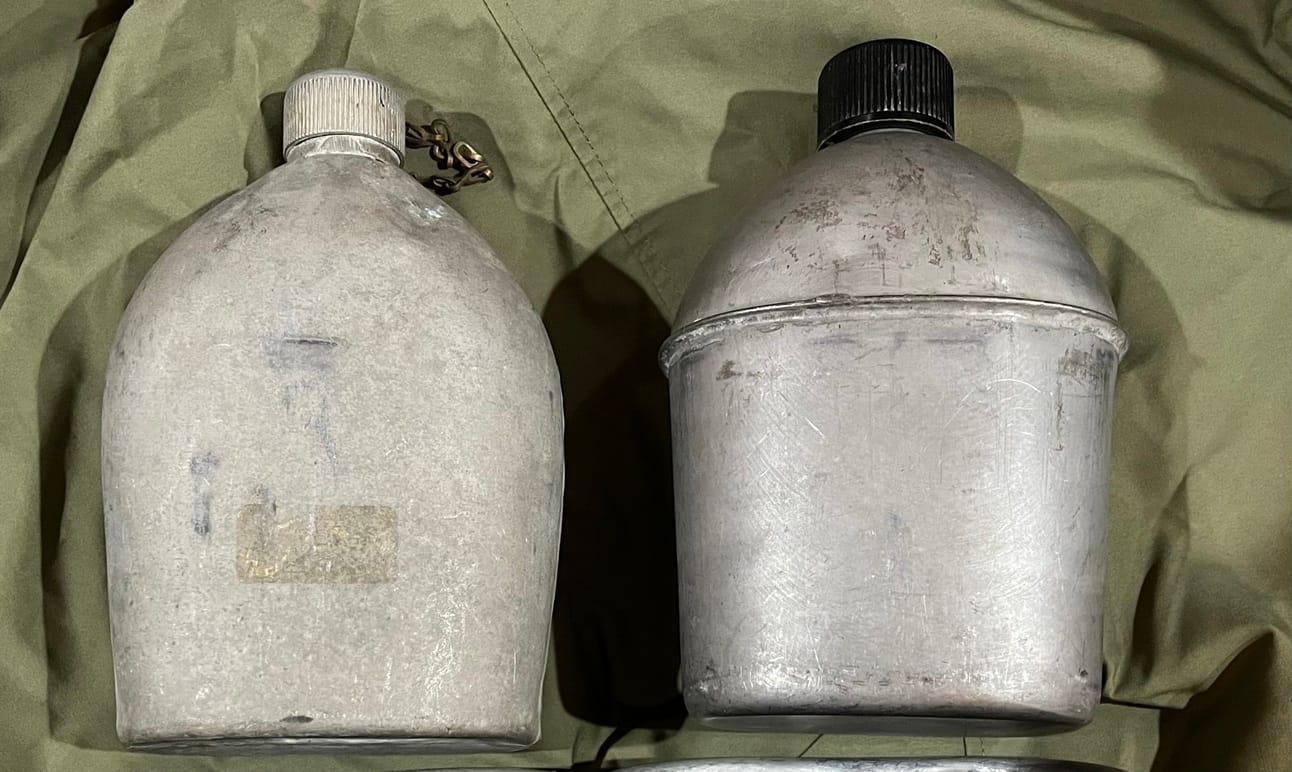
Options
Today we will stick strictly to the kidney shaped military designs for our discussion. This shape lends itself to belt carry, the curvature somehow fits every man’s beltline. There are tons of ruck carry options we will write about at a later date; the Nalgene bottles, camelbaks, 2 quart collapsible, and an endless array of cylinder-shaped vessels. But none of these are optimal for belt/LBE/harness carry so we use the GI type canteen. The choices in design are fairly limited, there is only so much a manufacturer can do without departing from the advantages of that 100 plus year-old design. The main differences for them are in the materials (for the most part). There are nuances like wide mouth designs, 1 liter vs 1 quart, or two piece construction but for the most part the type of material will define your options.
Metal or Plastic? This is the first big choice you will have to make based on your requirements and preferences. Cold weather use and the ability to place the canteen on a flame are decision criteria. What has worked for me is using metal in the cold of winter and stick with plastic during the other 3 seasons. I have had plastic GI canteens freeze and they still kept on ticking, but I have also seen them split. If you are in hard freeze conditions, you can opt for metal…or just roll the bones and hope for the best.
Metal. Aluminum, steel, or titanium are the choices.
Aluminum is lightweight, inexpensive, but can be prone to impact damage. The health implications of aluminum are always a concern, studies are conflicting about the alzheimer’s risk. But if you are low use / emergency use the risk will probably be minimal. But if you are low use / emergency use the risk will probably be minimal. Did I say that already? Aluminum can develop a taste over the long haul, but again if you stick with water only in the canteen and clean it you shouldn’t have issues.
Stainless is rugged and cheap, but you will pay a weight penalty. Steel is heavier than the aluminum and titanium but it is cheap (sometimes). The US military switched between aluminum, steel, and then both during WW2 due to the availability of aluminum. As with all things military it was not a question of which one was better for the fighting men, it came down to cost and availability.
Titanium. Ah yes, my favorite. Light, incredibly durable, and cheap. Wait. Definitely not cheap. Titanium is by far the most expensive option. While Ti canteens are still obscene $, we have seen those items come way down in price the last few years. Believe it or not Ti is as cheap as I’ve ever seen it. But like my buddy back home used to say “that’s like gettin’ a great deal on a Ferrari ain’t it?” Pardon me stewardess I speak hillbilly - what my friend means is no matter how good of a deal you get it is still going to be an expensive item. International trade changes may increase this; while I never want to recommend buying something (that isn’t what the project and this newsletter is about) if you are considering Ti you may want to jump sooner for the best price. Almost anything titanium is going to come out of Asia, but the quality control is usually high for these items (as is the price).
Plastic
When we (incorrectly) combine materials under the “plastic” category we do so knowing it is an inaccurate batching of materials but for simplicity's sake; we will say all plastics are plastic this morning. The advantage is they are light and crazy durable, they can take an inexcusable amount of abuse. You haven’t lived until you have seen canteens skipped down the company street by an enraged NCO. The downside of course is no direct flame or burners can be used.
The chemistry used to formulate plastic materials is complex and there seems to be a newest backpacker driven “won’t make you grow a third hand” health-healthy plastic formula each spring. Definitely avoid BPA, we know that for sure. The new US made GI canteens are BPA free (including the 2 quart collapsible). Look for a recycling code on the bottom of any plastic canteen, if they are marked with “7” inside the recycling symbol it can indicate polycarbonate which in turn could contain BPA. However, this code “7” is a catch-all category and is also used for BPA-free plastics. Older USGI canteens are more likely to contain BPA…and as a result so do all my fellow 90s and early 2000s Army vets. Thanks for your service you beautiful BPA infused bastards.

Cost. After the last four years of economic ass-whipping most of us are sensitive to how much things cost these days. The days of two dollar USGI (US Government Issue) surplus canteens are long gone, you might find a deal here and there at a flea market but they are rare. The Nalgene Oasis canteens used to be a great bargain, but I couldn’t find them for less than 16 bucks when I researched this week’s newsletter. A used USGI is running about 8 bucks, new is slightly more (depending on which cap you opt for). I hate commies, but the market reality is many of the good cheap options are coming out of chicom factories. I wouldn’t trust the off brand chicom plastics, but the stainless and aluminum may be an option for you. There is always a risk of lead with anything coming from them, but that is easily tested (remember the lead detection in those popular (with the girls) stainless tumblers last year?) Nalgene still manufactures some if not most of theirs in the US from US materials so I would trust those items, but there are some models they have manufactured overseas.
Should you buy New or Used? (surplus). My friends if you have ever spent any time around dudes in the field you will know to never ever buy a used canteen. Ever. Everything from Copenhagen spit to…yeah you don’t want to know. I know what you are thinking “who would ever put that in their own canteen?!!” The general public has no idea what Soldiers are like. The only thing I ever put in a canteen is water and maybe some electrolyte, but I have seen enough human condition in the Army to realize not everyone has the same idea of civilized canteen use. Yeah, I know… I got issued used canteens through my CIF issue for years (CIF is the consolidated gear issue where you get used stuff every time you change posts/units). I try not to think about it too much, it helps me sleep better at night if I don’t.
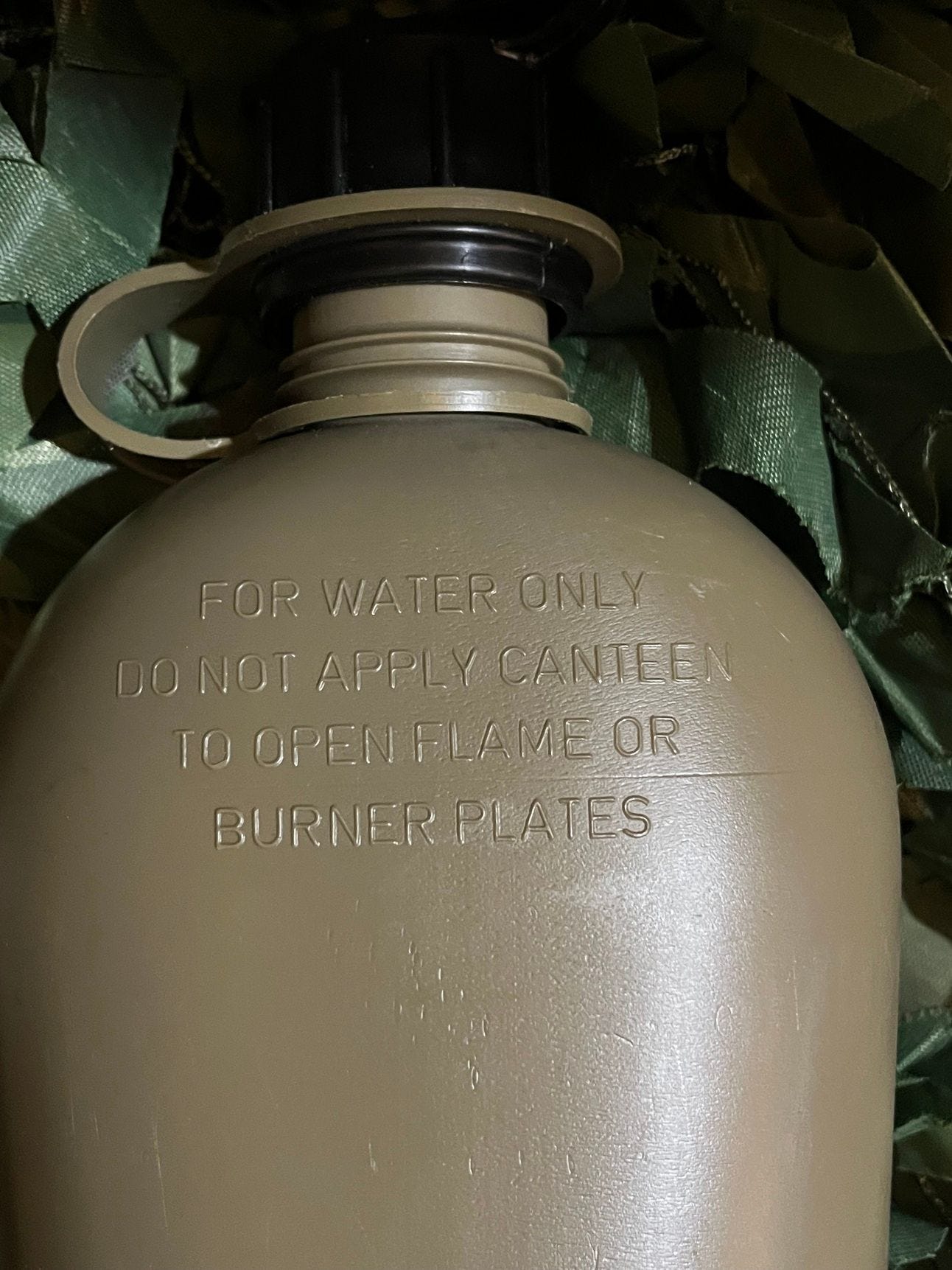
Cups. If you opt for canteens (always have two) I recommend having a cup for each. Yes, it is redundant but there is a reason. This is just basic infantry fieldcraft and keeping yourself healthy. My first platoon sergeant taught all of us to have two canteen cups, and it isn’t because of that overused “two is one, none is some something something” reason that people use. One cup is used for heating or consuming (METT-TC applies, no cookin’ on the OP there mister high speed). The second cup is used for hygiene (he had us paint or mark the hygiene specific one). Even if you aren’t shaving or doing those types of things you still need a way to maintain personal hygiene. Wipes only get you so far during extended periods, over the course of days or weeks you will need a way to contain water to use for hygiene reasons (if water is readily available / not scarce of course). It isn’t about feeling fresh, it is a matter of health and hygiene. And you sure don’t need to be drinking out of that same one in the field so get a second cup.
Canteen cup differences are mostly material based as well (steel, aluminum, titanium, plastic) with the same types of advantages and disadvantages. There is one glaring one and for me it is a deal breaker. For my cooking/water heating I always opt for titanium. Why? Because you can drink from a titanium cup that has hot liquid in it. Steel is terrible, the GI issue canteen cups are impossible to drink from when you take them off the stove due to the heat. Same with aluminum but to a lesser degree. Yeah, you can buy the silicone things to put around the rim but the hell with that. Look I don’t want to pay ‘fiddy bucks for a stupid titanium canteen cup either, but for me it is well worth it.
The handles are the second main difference between cup designs, some have short butterfly handles, some long handles, and some in between. There are also the “L” shaped old style handles from the M1910 and M1942 cups. Depending on if and how you heat your cup you may prefer one over the other. The short handle models can be challenging over twig stoves or open fires, gloves are definitely in order with those short handled ones.
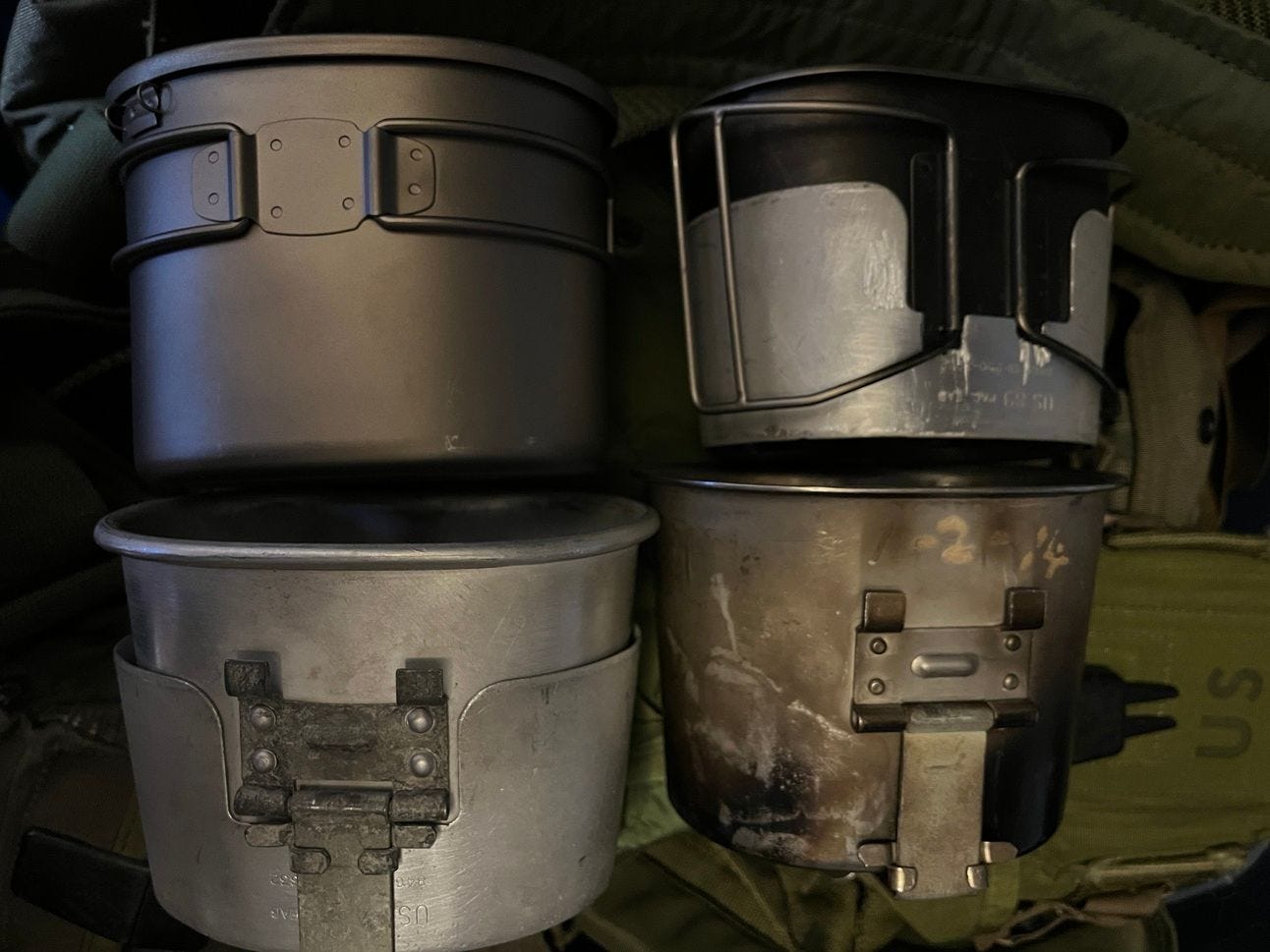
Stoves. First and foremost METT-TC always. When we are out woods bumming or hiking around enjoying the field (and we all should) a stove is always a great thing to have and a lot of fun to use. For mission use the conditions will always dictate if you should be heating up water (never outright cooking of course). In an emergency you may have to process water by boiling, but this comes with extreme risk if there is a threat of discovery. With that out of the way we can briefly talk a few options. The two traditional canteen related stove options are the canteen stove/stand or the folding scout stove (Esbit stove). neither of these is appropriate for rolling boil and processing water with solid fuel or alcohol, the heat calories just aren’t there unless you use a wood fire or opt for a canister stove. There are lots of other options that we have discussed in the past, but we will stick with these two stoves this morning.
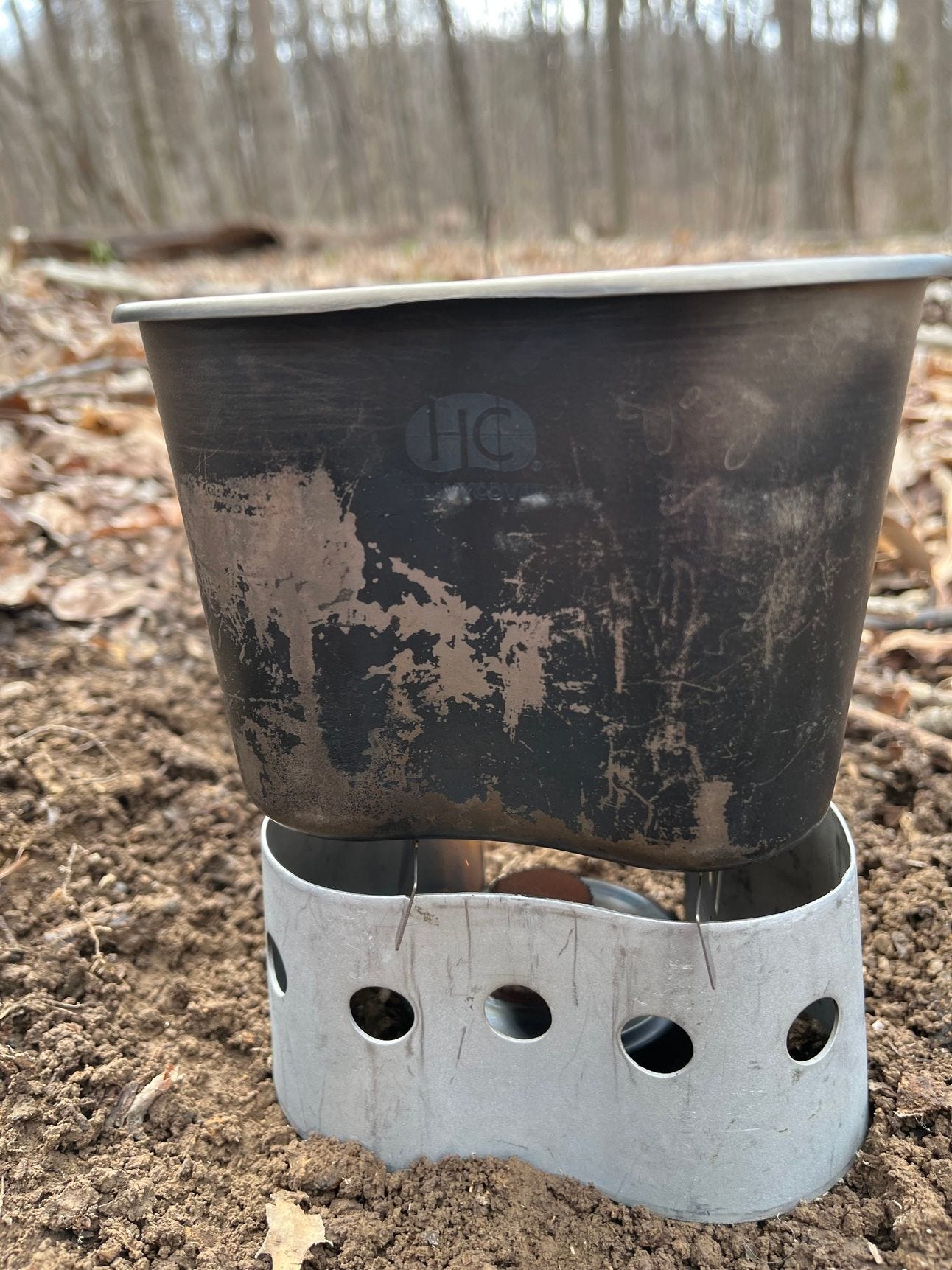
Canteen Stand/ Stove. These little guys are great and are the only real system type solution for a canteen set. If you mix and match canteens and cups you may have some adjustments to make but overall they will work with most options. They will nest with standard L handles really well and the issued butterfly handle. If you use a titanium cup (mine is from Heavy Cover) you may have to modify if you want it to nest. I had to give mine a set of Kentucky teeth to get it to fit over the handles and nest flush. You don’t have to do this, the stove will still nest it just sticks out a half inch or so below the cup. I didn’t want the relatively sharp edge of the rim to ride in the pouch, I could see it over time rubbing and cookie cutting through the bottom of the pouch. The stove has two design inefficiencies that can be easily remedied. If using hex fuel tabs the distance is too far, hex efficiency is best when it is 1.5 inches or so below the vessel. I simply put the fuel tab on a small light stand and problem solved. Part two is the cup nests neatly inside the stove when cooking on it. It is such a neat design, unfortunately it does not allow the flame to reach its potential. This is fixed by adding sections of wire coat hanger, titanium tent stakes, or crossbars to elevate the cup above the opening. Too easy. The TTP is also to reverse it 180 on the stove which kinda’ works, but I have found the crossbar solution to be optimal.
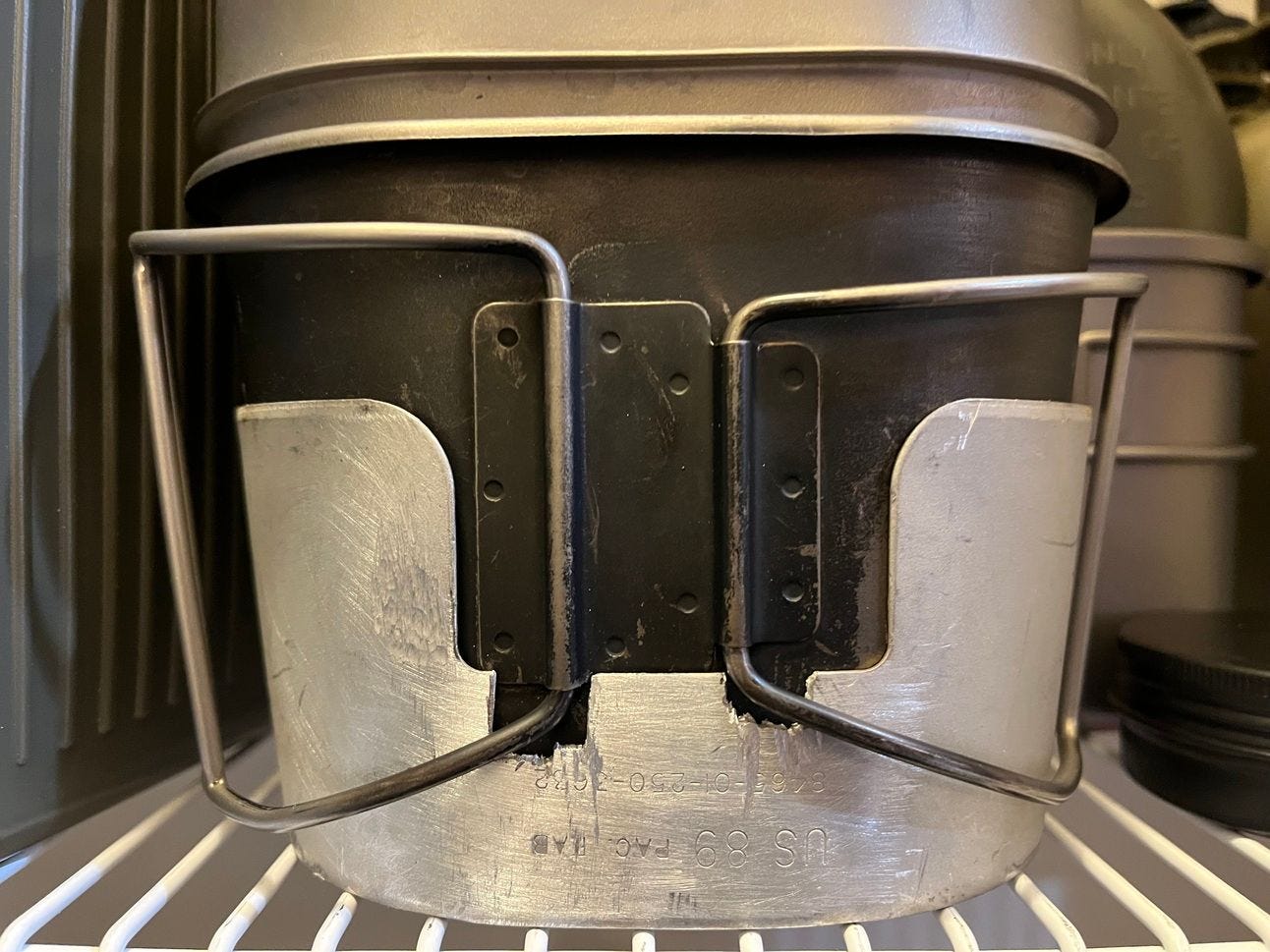
Scout Stove. The scout stove or folding Esbit stove is a light compact stove and has been in use for decades. They are not a nesting system like the canteen stand, but they are one of the traditional canteen stoves in widespread use. They are easy to use with a canteen cup, just watch the balance point as the cup can get a bit tippy on them.
Summary. I’m just wondering how I wrote a couple thousand words about canteens. And believe it or not I had to split it into two newsletter so we will discuss specific options next week. Hope you enjoyed this one, it is a simple subject but the choices can trip guys up sometimes and you can end up wasting money chasing bad solutions. Hopefully this will help you save some money and figure out what you need.
Canteen Options (Part 2)
Shared with permission from Jack Morris with The Professional Citizen Project Newsletter

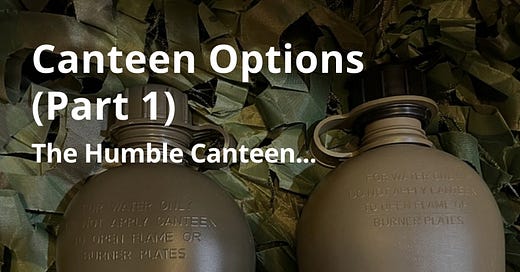


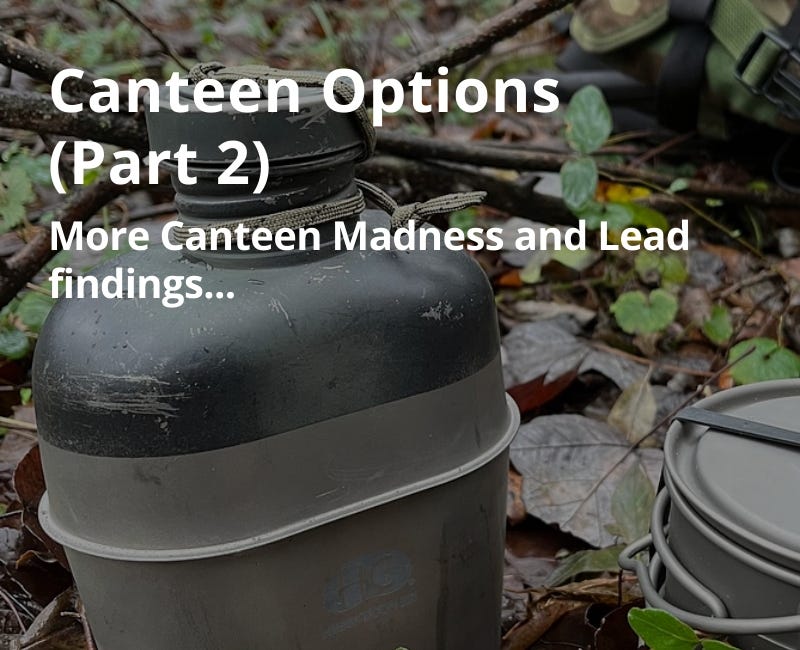
Very helpful! I have a WWII one as a collector. They are from my grandfather. I now use the new plastic USGI which work well.